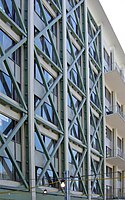
Photo from wikipedia
User-defined plastic hinge properties obtained experimentally are used to examine the structural behavior of bare, infilled walled frames with and without anchor bars in reinforced concrete (RC) buildings. Experimentally obtained… Click to show full abstract
User-defined plastic hinge properties obtained experimentally are used to examine the structural behavior of bare, infilled walled frames with and without anchor bars in reinforced concrete (RC) buildings. Experimentally obtained moment-curvature relationships of structural members (i.e., beams and columns) are used to determine the plastic hinge properties of each section. Three building frames are modeled and examined for time-history analysis using 20 ground-motion records. Seismic performance levels of three buildings are analyzed to determine the effects of anchor bars. Limit states at each performance level are defined, and the multi-record incremental dynamic analysis curves are obtained; 16%, 50%, and 84% fractal curves are obtained for each case. Cumulative distribution functions are constructed to summarize the varieties in the roof-drift ratios of three RC buildings with different frame types for design-based and maximum-considered earthquake hazards. It is found that, with an increased spectral acceleration of ground motions, the probability of exceeding the performance levels of infilled walled frames in reinforced buildings is reduced with the help of anchor bars. The increased stiffness of RC buildings with infilled wall frames exhibiting lower ductility is re-gained by the absorption energy of the anchor bars.
Journal Title: Ksce Journal of Civil Engineering
Year Published: 2020
Link to full text (if available)
Share on Social Media: Sign Up to like & get
recommendations!